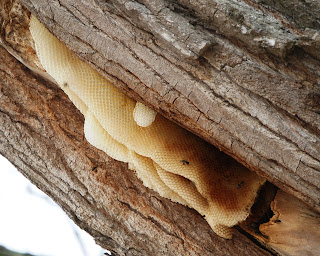We can learn much about honey bees by observing bees in their natural habitat. Residents of my Arkansas Delta county called today and described a colony of honey bees living in a huge, hollow cottonwood tree at their home. Cottonwoods are among the tallest trees in the Delta, climbing to nearly 150 feet. This gnarled tree had weathered many a season and showed the damage of numerous wind storms and lightning strikes. Hollow cavities in storm-damaged trees provide excellent spaces for honey bees to build their nests.
The colony moved into the ancient tree this past October. Colonies that swarm late in the year often fail to build enough comb and store a sufficient amount of honey to survive the winter. Fortunately, there was a good nectar flow from goldenrod this past fall. If you click on today’s photo, you can see the entrance to the natural honey bee nest about 23 feet above ground on the underside of a large, hollow limb. Four sheets of clean, light-colored beeswax honeycomb hang down from the opening in the tree. The darkened comb previously held brood and pollen. Like a screened bottom board on a modern bee hive, the open bottom of this natural nest allows hive debris and parasitic Varroa mites preened by the bees to fall to the ground. All of the exposed comb is empty; the bees have moved their cluster upward over the winter. The empty cells filled with air make excellent insulation for the colony’s nest. The sheets of comb themselves help calm the winter winds. The homeowner and I watched the honey bees actively flying from their natural nest. An international pilot, he discussed how insecticides are sprayed inside the cargo holds of aircrafts before landing in foreign countries to prevent the unwanted transfer of bees or other insects. This colony should be successful in its new home. It found a suitable tree and a family concerned with protecting the bees and the environment.
--Richard





Very interesting... I wish I could find a hive like that around here.
ReplyDeleteJames,
ReplyDeleteI am sure that you will get many calls from folks who want you to see the bees in the trees near their homes. Let me invite you to go to the Tennessee Beekeepers Association’s site, http://www.tnbeekeepers.org/, to find a local beekeeping association in your area. There are a number of active beekeeping groups in the Great Smoky Mountains area of east Tennessee that would be glad to share their experience with you.
--Richard
what a a great photo! wonderful that this late swarm was able to survive the winter. kudos to those clever scout bees - a good find on all counts.
ReplyDeleteRichard,
ReplyDeleteI really want to thank you for coming out to look the bees over and make sure they were ok!!
My father raised bees for years and would be so proud to know these have made a home with us. I will keep the fountain full of fresh water and let you know from time to time how they are doing. Again thank you- Joy Blankenship Terral - West Memphis
what a a great photo! wonderful that this late swarm was able to survive the winter. kudos to those clever scout bees - a good find on all counts. thanks
ReplyDelete